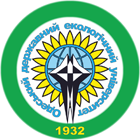Автори: О.Ю. Хецеліус, І.М. Серга, Д.Є. Сухарев, А.М. Шахман
Рік: 2015
Випуск: 19
Сторінки: 195-200
Анотація
Представлено ефективний релятивістський підхід до опису енергетичних та спектральних характеристик піонних атомів, який базується на рівнянні Клейна-Гордона-Фока з оптимізованим оптичним потенціалом сильної піон-нуклонної взаємодії і методі релятивістської багаточастинкової теорії збурень (ТЗ) з гамільтоніаном “0” наближення Дірака-Брейта-Кона-Шема (наближення до формально точної КЕД ТЗ) і коректним урахуванням релятивістських, радіаційних КЕД ефектів, ядерних ефектів кінцевого розміру ядра плюс ядерної квадрупольної деформації, а також електрон-екранувального ефекту (електромагнітний блок). Затравочний потенціал взаємодії в системі представлений у вигляді суми оптичного потенціалу π–-N взаємодії, релятивістського кулонівського потенціалу, який описує взаємодію піона з ядром з урахуванням поправки Breit-Rosenthal-Crawford-Schawlow на кінцевий розмір ядра; узагальненого радіаційного потенціалу, що враховує основний КЕД ефект поляризації вакууму та ін., і самоузгодженого потенціалу виживших електронних оболонок. Для цілого ряду важких π–-А, у т.ч., π––181Ta,197Au,203Tl,208Pb,209Bi, отримані значення обумовлених сильною π–-N взаємодією, зміщень і ширин 4f,3d рівнів, включаючи поправку, пов’язану безпосередньо з ефектом ядерної квадрупольної деформації. Для ряду π–– А дані по зміщенням і ширинам рівнів у спектрі представлені вперше.
Теги: зміщення іняння Клейна-Гордона-Фока; оптичний потен ширини енергетичних рівні; оптичний потенціал π--N
Список літератури
- Yang F., Hamilton J.H. (Eds). Fundamentals of nuclear models. Singapore: World Scientific, 2010. 740 p.
- Marciano W., White S. (Eds). Electromagnetic Probes of Fundamental Physics. Singapore: World Scient, 2003. 560 p.
- Ericson T., Ericson T., Weise W. Pions and Nuclei. Oxford: Clarendon, 1988. 320 p.
- Deloff A. Fundamentals in Hadronic Atom Theory. Singapore: World Sci., 2003. 352 p.
- Scherer S. Introduction to Chiral Perturbation Theory. Advances in Nuclear Physics. Springer (Berlin), 2003, vol.27, pp. 5-50. (Eds: Negele J.W., Vogt E.W.).
- Anagnostopoulos D., Biri S., Boisbourdain V., Demeter M., Borchert G. et al. -PSI Low-energy X-ray standards from pionic atoms. Nucl. Inst. Methods B., 2003, vol.205, pp. 9-18.
- Itahashi K., Berg G., Fujioka H., Geissel H., Hayano R. et al. First pionic atom spectroscopy at RIBF. EPJ Web of Conf., 2012, vol.37, pp. 01013-01036.
- Glushkov A.V. Relativistic Quantum Theory. Quantum, mechanics of Atomic Systems. Odessa: Astroprint, 2008. 900 p.
- Khetselius O.Yu. Hyperfine structure of atomic spectra. Odessa: Astroprint, 2008. 210 p.
- Khetselius O.Yu. Relativistic perturbation theory calculation of the hyperfine structure parameters for some heavy-element isotopes. Int. Journ. of Quantum Chemistry, 2009, vol.109, no. 14, pp. 3330-3335.
- Glushkov A.V, Khetselius O.Yu., Loboda A.V, Shakhman A.N., Svinarenko A.A., Florko T.A. Frontiers in Quantum Methods and Applications in Chemistry and Physics. Springer, 2014, vol.33, pp. 71-94.
- Glushkov A.V., Khetselius O.Yu., Svinarenko A.A. Relativistic theory of cooperative muon-gamma-nuclear processes: Negative muon capture and metastable nucleus discharge. Advances in the Theory of Quantum Systems in Chemistry and Physics. Springer, 2012, vol.22, pp. 51-70.
- Shakhman A.N. Relativistic theory of spectra of heavy pionic atoms with account of strong pion-nuclear interaction effects: new data for 175Lu, 205Tl, 208Pb. Photoelectronics, 2014, no. 23, pp. 71-75.
- Serga I.N., Dubrovskaya Yu.V., Shakhman A.N., Kvasikova A.S., Sukharev D.E. Spectroscopy of hadronic atoms: Energy shifts. Journal of Physics: C Ser. (IOP, London, UK), 2012, vol.397, pp. 012013-012018.
- Olaniyi B., Shor A, Cheng S., Dugan G., Wu C.S. Electric quadru-pole moments and strong interaction effects in piomic atoms of 165Ho, 175Lu, 176Lu,179Hf, 181Ta. Nucl.Phys.A., 1982, vol. 403, pp. 572-588.
- Erikcson M., Ericson T., Krell M. Peculiarities of the pion-nuclear interaction. Phys.Rev.Lett, 1969, vol.22, pp. 1189-1193.
- Ericson M., Ericson T. Optical properties of low-energy pions in nuclei. Ann. Phys., 1966, vol.36, pp. 323-362.
- Tauscher L. Analysis of pionic atoms and the π-nucleus optical potential. Proc.of the International Sem. “π-Meson Nucleus Interaction”. CNRS-Strasbourg (France), 1971, pp.45-68.
- Batty C.J., Biagi S.F., Friedman E., Hoath S.D. Shifts and widths of 2p levels in pionic atoms. Phys. Rev. Lett, 1978, vol.40, pp. 931-935.
- Batty C.J., Friedman E., Gal A. Saturation effects in pionic atoms and the π-nucleus optical potential. Nucl. Phys.A., 1983, vol.402, pp. 411-428.
- Seki R., Masutani К., Jazaki К. Unified analysis of pionic atoms and low-energy pion-nuclear scattering. Hybrid analysis. Phys. Rev.C., 1983, vol.27,. pp. 1817-2832.
- Rowe G., Salamon M., Landau R.H. Energy-dependent phase shift analysis of pion-nucleon scattering below 400 MeV. Phys. Rev. C., 1978, vol.18, pp. 584-596.
- Backenstoss G. Pionic atoms. Ann.Rev.Nucl.Sci., 1970, vol.20, pp. 467-510.
- Indelicato P., Trassinelli M. From heavy ions to exotic atoms. arXiv:physics, 2005, vol.1, pp. 0510126-0510141.
- Santos J., Parente F., Boucard S., Indelicato P. Desclaux J.X-ray energies of circular transitions and electron scattering in kaonic atoms. Phys.Rev.A., 2005, vol.71, pp. 032501.
- Mitroy J., Ivallov I.A. Quantum defect theory for the study of hadronic atoms. J. Phys. G. Nucl. Part. Phys, 2001, vol.27, pp. 1421–1433.
- Anagnostopoulos D., Gotta D., Indelicato P., Simons L.M. Low-energy X-ray standards from hydrogenlike pionic atoms. arXiv: physics, 2003, vol.1, pp. 0312090-0312097.
- Nagels M.M., de Swart J., Nielsen H. et al. Compilation of Coupling Constants and Low-Energy Parameters. 1976 Edition. Nucl.Phys.B., 1976, vol.109, pp. 1-90.
- Lauss B. Fundamental measurements with muons -View from PSI. Nucl.Phys.A., 2009, vol.827, pp. 401-407. PSI experiment R-98.01, http://pihydro gen.psi.ch
- CERN DIRAC Collaboration, “Search for long-lived states of π+ π– and π– K atoms”, CERN-SPSLC-2011-001 SPSLC-P-284-ADD. 2011. 22 p.
- CERN DIRAC Collaboration, „Status report of DIRAC for the SPSC meeting of March 2011”, CERN-SPSC-2011-013 ; SPSC-SR-081. 2011. 32 p.
- Itoh1 S., Berg G., Geissel H., Hayano R., Inabe Itahashi K. Precision spectroscopy of pionic atom at RIKEN-RIBF. Proc. of the XIV International Conference on Hadron Spectroscopy. Munich (Germany), 2011, p. 4.
- Ishiwatari T. Silicon drift detectors for the kaonic atom X-ray measurements in the SIDDHARTA experiment on behalf of the SIDDHARTA Collaboration. Nucl. Instr. and Methods in Phys. A: Accelerators, Spectrometers, Detectors, 2007, vol.581, pp. 326-329.



